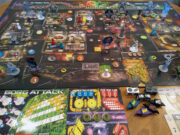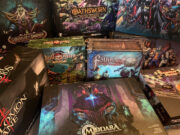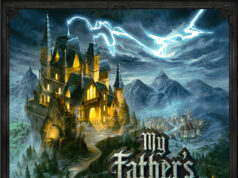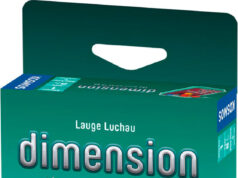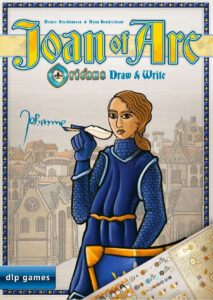 Joan of Arc was a heroic fighter who helped lead the French Army to a victory at the city of Orleans. So, using her name for a draw and write follow-up to the successful board game Orleans makes perfect sense. Using her name for the multiplayer version of this game, in which you compete to gain the best followers for your chosen strategy for victory, is questionable. It is redeemed in the single player mode where you compete against Joan of Arc herself.
Joan of Arc was a heroic fighter who helped lead the French Army to a victory at the city of Orleans. So, using her name for a draw and write follow-up to the successful board game Orleans makes perfect sense. Using her name for the multiplayer version of this game, in which you compete to gain the best followers for your chosen strategy for victory, is questionable. It is redeemed in the single player mode where you compete against Joan of Arc herself.
I need to disclose that I have only payed Orleans once in my life and it was likely in 2014 or 2015, so I do not recall the game at all. I feel that familiarity with the game Orleans might alter your enjoyment of this game, whether, for the better or the worse, I am not sure. This review should be seen as a stand-alone review which will be more beneficial for gamers that are unfamiliar with the original game Orleans.
Gameplay Overview:
Like most * (roll, draw, etc) and Write games, each player has their own sheets in which they circle and cross out items as they earn or spend them. In Joan of Arc, there are variable turns per round based on player count and five total rounds (The instructions are AWFUL. They don’t refer to them as turns, but only rounds, so I am clarifying).
At the start of each turn, the first player draws a number of followers out of the bag and places them in front of all players.
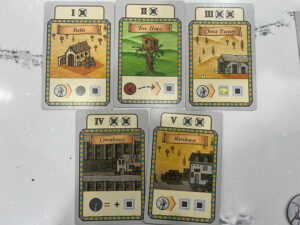
Starting with the first player, each player selects one follower and then performs one single action from the following options:
1. Perform one Standard action (each follower type has their own standard action, but most involve crossing things out or drawing routes on your sheet)
2. Perform one Location action (Starting on the turn after you buy a location, you may use the upgraded follower ability on the location once per turn instead of the Standard Action.)
3. Fill in one Beneficial Deed Follower Circle (Each Banner gives both a reward other players can receive and a first to complete reward that opponents must cross out once a player receives the reward.)
Once all followers are selected, (the first player gets to select one more follower than other players), the bag is passed to the next player and they are the first player for this turn.
The Round Ends when the bag is empty, you mark off on each player’s sheet that the round is over, when the bag is empty 5 times the game ends.

Game Experience:
Somehow I am reviewing another * and write, review my previous reviews that indicate it is not my favorite genre. This experience needs to be broken up into three parts, The Rule Book, The Sheet, and The Game.
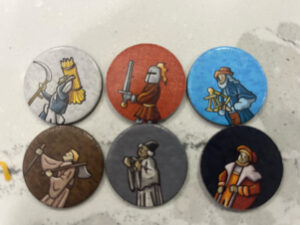
The Rule Book: The rule book can ruin this game. It is arguably the worst rule book I have ever read. The organization of the pages makes little sense and in a rule book that is only 7 pages, I flipped back and forth an insane number of times. But even worse, the rulebook doesn’t even bother to explain the theme of the game as there is no connection to Joan of Arc, and the types of followers and goods you are collecting are never named. The only way I was able to identify the ones I have listed above is because in the single player instructions they name 5/6 followers and in the location card explanations at the back of the rule book they name 3/5 of the goods. There is no thematic explanation of the Depot or Beneficial Deeds or what you are developing on the Development Track that gives you bonuses and multipliers. It’s just a bunch of point and reward salad. I frequently complain that writing based games lack connection to theme, but this rule book completely ignores theme.
Rule Book 0/5.0
The Sheet:
If you are over 40, go to the nearest pharmacy and buy readers because the nondescript goods on the map are difficult to differentiate, and if you are colorblind and over 40 good luck figuring out the difference between scholars and craftsmen on the sheet. Once you become familiar with the sheet it does make the game easier or just make sure you play with someone young enough to have good eyesight. The sheet also has nice divisions for 2, 3, or 4+ player counts and the back side is for solo mode and is slightly easier to read. My other complaint is that nearly 1/4 of the sheet is wasted on locations that you only use in your first game. After the first play of the game you use location cards. They could have made the player sheet easier to read by having you use location cards for every game and making the map or the symbols bigger.
The Sheet: 1.0/5.0
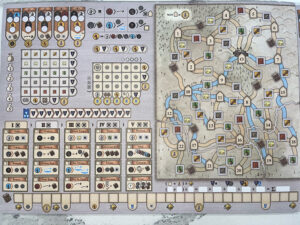
The Game:
Once you have interpreted the terrible rule book and deciphered the less than ideal sheet, the game is actually easy to play and fun. There are multiple strategies that you can use to win, but being the first to fill and spend your bank seems to be the most effective strategy. Tier IV and V locations are also very valuable. While it is primarily a multiplayer solitaire game, paying attention to how close your opponents are to earning the yellow octagon single-time rewards is important and can influence which follower you take and which locations you purchase. The game is listed as ages 10+ and this seems relatively accurate. My nine-year-old played without difficulty and really enjoyed the game, but he did not play in the frustrating first learning game, so I was able to explain the rules to him. There is no reading required as it is all symbol based which does mean a younger player is not at a significant disadvantage. You use four location cards per tier, but six cards per tier are included in the game offering some variability, but I wish there were more included. The game takes roughly an hour to play with time decreasing with subsequent plays.
Final Thoughts:
Joan of Arc is considered a martyr by the French and the Catholic Church, but I feel like the true martyr is me… for having to figure out this game while being colorblind and in my 40’s. That being said if you like roll and writes or drafting multiplayer solitaire games, like Azul, Orleans Draw and Write could hit a sweet spot for you. If you like your game’s theme to be clear maybe avoid the multiplayer version of this game. I am not a solo board game player, but the theme is more evident as you are competing directly against Joan of Arc in the solo mode, but the other flaws in theme still exist.
Final Score: 2.5 Stars – First play 1.0/5.0, second 2.0/5, third play 3.0/5 It should never take me three plays to make a game above average, but now that it is above average, I am probably stuck squinting at this game for a bunch more plays as my family likes it more than I do.
 Hits:
Hits:
• The variety of strategies that you can use to win.
• The speed at which the game plays once the rules are understood. Unlike many games later rounds tend to go faster than early rounds.
• The variability of locations each game forces people to change their strategies
Misses:
• The Rule Book
• The size and coloring of the sheet.
• The complete lack of theme.



